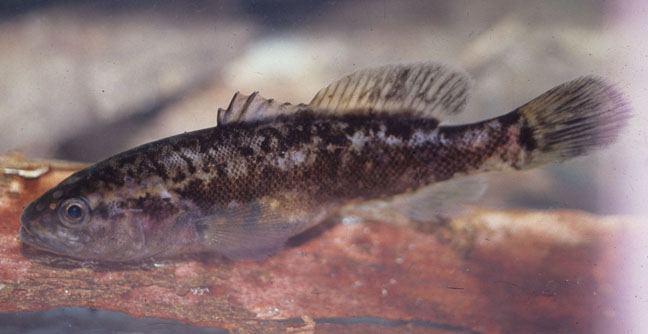Nightfish, Bostockia porosa Castelnau 1873

Nightfish, Bostockia porosa. Source: Michael Hammer. License: all rights reserved
The Nightfish is endemic to the southwest coast of Western Australia.
Identifying features:
Mouth large, head and snout with large conspicuous pores;
Dark olive-brown to almost black with a mottled pattern.
Nightfish, Bostockia porosa Castelnau 1873
More Info
|
Distribution |
Widespread in south-west Western Australia from the Hill River near Jurien Bay, to the Kalgan River near Albany. The Nightfish inhabits clear or tannin-stained freshwater rivers, streams, swamps and lakes around aquatic plants, woody debris or rocks for cover. Shelters in rock crevices and around vegetation during the day and is active at night. |
|
Features |
Meristic features: Body oblong and compressed, greatest depth 3-3.6 in SL; head length 2.75-3.2 in SL; eye diameter 4.4-5.6 in HL; mouth large, oblique; lower jaw protrudes slightly; maxilla with a supplemental bone, reaches to hind edge of pupil; jaws, vomer, and palatines with bands of villiform teeth; lateral line incomplete; large conspicuous open pores around eyes, along upper part of operculum, around preoperculum and along mandible; preoperculum serrated along edge and sometimes along ridge; operculum ends in a double spine. Spinous and soft portions of dorsal fin united but separated by a deep notch; 3rd-4th spines longest; 2nd anal spine longest; pectoral fin equal to postorbital part of head and inserted opposite ventral fin; posterior part of dorsal fin, anal and caudal fins rounded. |
|
Size |
To 15 cm SL; commonly 7.5-10 cm SL |
|
Colour |
Dark brown mottled with tawny and grey; paler ventrally; fins dusky brown to tan with dark brown spotting. |
|
Feeding |
Carnivorous feeding on a variety of benthic organisms, in particular ostracods and dipteran larvae. |
|
Biology |
Spawns in small tributaries in August and September after winter rains when freshwater discharge is high and temperatures and daylight length have begun to increase. Males become mature after their first year and females after their second. |
|
Fisheries |
May occasionally appear in the aquarium trade. |
|
Conservation |
|
|
Remarks |
A solitary, nocturnally active species. Maximum life span is about 6 years. |
|
Similar Species |
Bostockia porosa is one of the smallest members of the Percichthyidae family and the only member of the genus found in south Western Australia. |
|
Etymology |
Species name porosa is derived from the Greek poros (passage way, pore, opening) meaning ‘bearing pores’ in reference to the conspicuous pores on the head and snout of this species. |
|
Species Citation |
Bostockia porosa Castelnau, 1873, Proc. Zool. Acclim. Soc. Vict. 2: 126. Type locality: Cygnes River, interior of Western Australia. |
|
Author |
Vanessa J. Thompson & Dianne J. Bray |
Nightfish, Bostockia porosa Castelnau 1873
References
Allen, G.R. (1982). Inland Fishes of Western Australia. Perth : Western Australian Museum 86 pp. 6 figs
Allen, G.R. (1989). Freshwater Fishes of Australia. Neptune, New Jersey : T.F.H. Publications pp. 1–240
Allen, G.R., Midgley, S.H. & Allen, M. (2002). Field guide to the freshwater fishes of Australia. Perth : Western Australian Museum 394 pp. [193].
Castelnau, F.L. de (1873). Contribution to the ichthyology of Australia. 8. Fishes of Western Australia. Proc. Zool. Acclim. Soc. Vict. 2: 123–149
Merrick, J.R. & Schmida, G.E. (1984). Australian Freshwater Fishes Biology and Management. Sydney : J.R. Merrick 409 pp.
Pen, L.J. & Potter, I.C. (1990) Biology of the Nightfish, Bostockia porosa Castelnau, in a South-western Australian River. Aust J Mar Freshw Res 41(5) 627 - 645.
Pen, L.J. and I.C. Potter, 1991. Biology of the western pygmy perch, Edelia vittata, and comparisons with two other teleost species endemic to southwestern Australia. Environ. Biol. Fish. 31(4):365-380.

